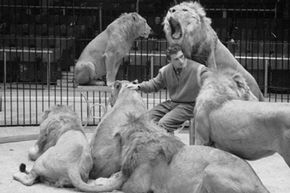It was meant to be a jaw-dropping circus act. As the lights went up in the arena, the attention of 6,500 spectators turned to eight acrobats hanging by their hair high above the floor.
Then, just as quickly as the aerial performance began, it ended. The aerial performers and the heavy dome-shaped rigging from which they were suspended plummeted 30 feet, resulting in serious injuries to the aerialists and another performer below. On that day, being part of a "human chandelier" was the most dangerous job at the circus [source: Steele].
Advertisement
But this distinction can vary. From lion taming to acrobatics, there's no shortage of danger. In fact, for many audience members, seeing performers attempt precarious and daring acts is part of the appeal. The entertainment, however, comes at a price.
According to the U.S. Bureau of Labor Statistics (BLS), there were 35 deaths among all performing arts companies in the United States in 2013, the latest year for which data is available. Circus performers fall within the "performing arts" category. The number of reported deaths is down from 40 in 2012, 49 in 2011 and 50 in 2010. In addition, an estimated 7.2 out of every 100 full-time workers in the industry became injured or ill in 2013, up from 5.2 in 2012 [source: BLS].
As for narrowing down the most dangerous circus job, take your pick. Nearly any performance could turn injurious in a split second. Take the daredevil tight rope act once performed by the "Flying Wallenda" family, for example. Beginning in 1948, the family's act involved constructing a human pyramid atop a thin high wire during circuses. With four men as the base, the family would balance a second tier of two more men atop shoulder beams and then a third tier composed of a woman atop a chair. It worked well until 1962, when someone's footing failed and the performers plummeted to the venue floor. Two died, one was paralyzed and the rest performed again the next night [source: Lammie]. The show must go on, it seems.
Other acts, including equestrian trick riders, elephant riders and trapeze artists face injury every time they perform. To maximize their safety, many start practicing their performances low and slow. They practice at manageable heights and speeds, increasing the risk as they master the performance at hand, taking advantage of safety gear as they're able. It's not a fail-proof method, but it's safer than the alternative.
Advertisement


